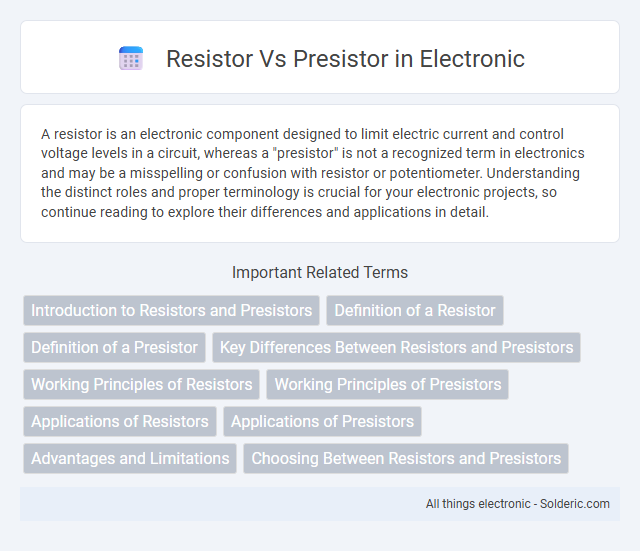A resistor is an electronic component designed to limit electric current and control voltage levels in a circuit, whereas a "presistor" is not a recognized term in electronics and may be a misspelling or confusion with resistor or potentiometer. Understanding the distinct roles and proper terminology is crucial for your electronic projects, so continue reading to explore their differences and applications in detail.
Comparison Table
| Feature | Resistor | Presistor |
|---|---|---|
| Definition | Passive electrical component that limits current flow. | Variable resistor designed for precision adjustments. |
| Function | Provides fixed resistance in circuits. | Allows tuning or calibration by varying resistance. |
| Type | Fixed or non-adjustable resistor. | Adjustable or trimmable resistor. |
| Application | Current limiting, voltage division, heat generation. | Calibration, fine-tuning circuits, sensor trimming. |
| Adjustment | No adjustment possible after manufacture. | Resistance can be adjusted during or after manufacturing. |
| Accuracy | Standard tolerance (+-1% to +-10%). | High precision, often tighter tolerance. |
| Symbol | Standard resistor symbol in circuit diagrams. | Variable resistor or trimmer symbol. |
Introduction to Resistors and Presistors
Resistors are passive electrical components designed to limit current flow and adjust signal levels in electronic circuits, characterized by their resistance value measured in ohms (O). Presistors, often confused with resistors, are specialized variable resistors used primarily in pressure-sensing applications, converting mechanical pressure into a measurable electrical resistance change. Understanding the fundamental differences in construction and function between fixed resistors and pressure-sensitive presistors is essential for precise circuit design and sensor integration.
Definition of a Resistor
A resistor is an electrical component that limits or regulates the flow of electric current in a circuit by providing a precise amount of resistance measured in ohms. It is used to control voltage and current to protect other components and ensure proper circuit functionality. Your electronic device relies on resistors to maintain stable performance and prevent damage from excessive current.
Definition of a Presistor
A presistor is a specialized sensor designed to measure pressure by converting mechanical force into an electrical signal, commonly used in industrial and automotive applications. Unlike a resistor, which primarily limits electric current within a circuit through a fixed or variable resistance, presistors function as pressure-sensitive components that respond to changes in physical pressure. The key defining feature of a presistor is its ability to provide accurate, real-time pressure readings, making it essential in systems that require precise pressure monitoring and control.
Key Differences Between Resistors and Presistors
Resistors are passive electrical components that provide a fixed resistance to limit current flow in circuits, while presistors are not standard electronic components and may be a typographical error or confusion with pressure sensors. Resistors dissipate electrical energy as heat and are characterized by resistance values measured in ohms (O), whereas pressure sensors measure physical pressure and convert it into electrical signals. Key differences lie in their function, application, and electrical properties: resistors control current in electronic circuits, whereas pressure sensors (often mistaken as presistors) detect and monitor pressure changes.
Working Principles of Resistors
Resistors operate by limiting the flow of electric current through a conductive material, converting electrical energy into heat based on Ohm's Law (V = IR). Their resistance value depends on factors such as material composition, length, cross-sectional area, and temperature coefficient. The working principle of resistors is fundamental in controlling voltage and current within electronic circuits, ensuring device protection and signal regulation.
Working Principles of Presistors
Presistors operate based on the principle of variable resistance controlled by external stimuli such as pressure, temperature, or voltage, allowing them to respond dynamically to changes in their environment. Unlike traditional resistors that maintain a fixed resistance, presistors adjust their resistance value, making them ideal for sensing and control applications. Understanding the working principles of presistors helps you select the right component for precise measurement and real-time system feedback.
Applications of Resistors
Resistors are essential components used in electronic circuits to control current flow, divide voltages, and protect sensitive components from damage. Common applications include voltage regulation in power supplies, signal conditioning in sensors, and current limiting in LED circuits. Your electronic projects benefit from resistors' ability to ensure stable operation and prevent circuit failures.
Applications of Presistors
Presistors, commonly used in industrial automation and motor control applications, provide precise resistance adjustments for optimizing circuit performance under varying electrical loads. Their robust design makes them ideal for measuring, controlling, and protecting electrical equipment in harsh environments, unlike standard resistors primarily used for simple current limiting and voltage regulation. Your choice of presistors ensures reliable and accurate functionality in systems requiring high stability and durability.
Advantages and Limitations
Resistors offer precise resistance values and stability, making them ideal for controlling current and voltage in circuits with consistent performance across temperature variations. Presistors, designed for pressure sensitivity, provide dynamic resistance changes useful in sensors but may suffer from limited accuracy and durability compared to fixed resistors. Your choice depends on whether you need stable resistance for standard applications or variable resistance responsive to physical pressure.
Choosing Between Resistors and Presistors
Choosing between resistors and presistors depends on your application's specific requirements for resistance accuracy, power dissipation, and stability. Resistors offer fixed resistance values with low cost and wide availability, ideal for most general circuits. Presistors, often combining resistive and protective features, are suitable when enhanced durability against environmental factors or precise performance under varying conditions is necessary.
resistor vs presistor Infographic

 solderic.com
solderic.com